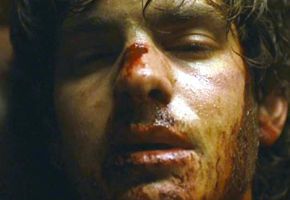TMNT: The Last Ronin Originally Had Raphael Nearly Kill Splinter

Warning! This article contains spoilers for Teenage Mutant Ninja Turtles: The Last Ronin #1 and #2.
The Last Ronin paints a bleak portrait for the future of the Teenage Mutant Ninja Turtles – at least for the one turtle that’s still alive. Set in a dystopian New York City, the story follows Michaelangelo, the sole surviving Hero in a Half Shell, as he wages war on a new generation of Foot Clan to seek vengeance for his fallen brothers.
The story was first conceived in 1987 by TMNT creators Kevin Eastman and Peter Laird, and over the years, the script evolved pretty significantly. Now fans can get a peek at the creative process behind The Last Ronin‘s creation. A Director’s Cut Edition of the first issue has been released by IDW Publishing containing a plethora of behind-the-scenes notes, concept art, scrapped ideas, pages of the original script, and more. The book reveals that Michaelangelo was always meant to be the last Turtle standing, but in the original designs, Mikey was blind in one eye due to damage sustained in battle. Casey Jones was meant to die in the script’s very first page. April O’Neil is paralyzed from a Foot Clan attack (as opposed to being an amputee in the final version). But possibly the biggest change was why the Turtles broke up in the first place.
The original, 34-year-old script opens with the brothers in turmoil. For unspecified reasons, Raphael has brutally assaulted Master Splinter, leaving the anthropomorphic rat badly injured. Raph, despondent over his actions, leaves, never to be seen or heard from again. Still reeling over what had transpired, the remaining Turtles are shocked again when Splinter, having recovered from his injuries, declares he’s returning to Japan to live out his remaining days. Donatello accompanies him, Leonardo and Michaelangelo eventually part ways and the Teenage Mutant Ninja Turtles are no more.
The inside look @kevineastman86 process for creating TMNT: The Last Ronin #1 Director’s cut is incredible.
Go get your copy out this week!👊 pic.twitter.com/ipBV5B6LMj— IDW Publishing (@IDWPublishing) March 15, 2021
Things play out very differently in the series that’s currently running. In The Last Ronin #2, Splinter is mortally wounded, but this time it’s from a Foot Clan ambush as opposed to one of his adoptive sons. Raphael, in a way, is still responsible for the beginning of the end of the Turtles, as he furiously charges into battle with the Clan. He cuts a bloody path through dozens of minions in his rage before he, too, eventually succumbs to his battle wounds, marking the end of the TMNT era.
Raph has always been the short-tempered, impetuous member of the Turtle family. Some might go so far as to call him “cool but rude.” Still, brutally attacking his master – the closest thing to a father figure he’s ever known – would likely have made readers’ jaws drop. And while this all may sound somewhat hardcore to TMNT fans that grew up on the Saturday morning cartoons, it’s important to note that when Eastman and Laird launched the books in 1984, they were much darker in tone. The Turtles used lethal force and the very first issue ended with Shredder falling from a rooftop to his death. So while Raph turning on his master likely would have shocked readers at the time, the apparent ferocity with which he did so likely wouldn’t have.

Today the Turtles are mostly known as the fun, wise-cracking, kid-friendly team that has seen countless reboots throughout comics, movies, and TV over the decades. The Last Ronin, however, has been lauded as a return to form for the series. Only two issues – plus the Director’s Cut – have been released so far, but they take readers back to the Ninja Turtles’ bloodied, war-torn, deadly violent roots. The Director’s Cut especially is essential reading for any die-hard fans looking for a peek behind the curtains. It’s a shame that Teenage Mutant Ninja Turtle devotees will likely never know why exactly Raphael attacked Splinter in the original script, but at least there’s solace to be found in knowing there are three more issues of The Last Ronin to come.
About The Author

















